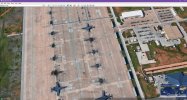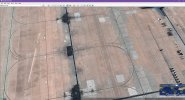fizzBuzz
Active Member
So I saw this tweet:
Source: https://twitter.com/iluminatibot/status/1755305484565852513
And decided to look at it myself. It's located at the Dyess Air Force Base in Abilene, Texas: 32.414360, -99.844289
There definitely appears to be some sort of light refraction going on, just based on the concrete tiling below the object.

And Google Earth seems to think there is a "plane" shaped object there which has a very similar shape to the other "non-cloaked" plane.

Has anyone seen this before? What could this be? Could this just have been a manual(or automated) edit to the image to removed a plane?
Source: https://twitter.com/iluminatibot/status/1755305484565852513
And decided to look at it myself. It's located at the Dyess Air Force Base in Abilene, Texas: 32.414360, -99.844289
There definitely appears to be some sort of light refraction going on, just based on the concrete tiling below the object.
And Google Earth seems to think there is a "plane" shaped object there which has a very similar shape to the other "non-cloaked" plane.
Has anyone seen this before? What could this be? Could this just have been a manual(or automated) edit to the image to removed a plane?


